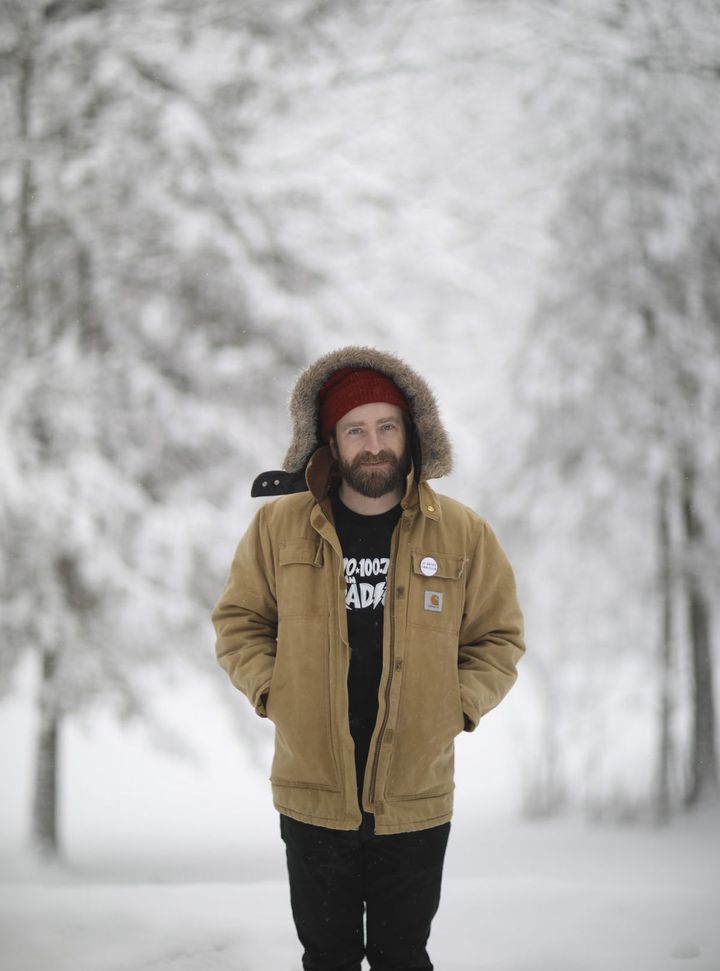
“Furnace” is a full experience, lonely, personal and yet joyfully inscrutable. Though Dave Simonett, aka “Dead Man Winter” lets his thoughts run off course as the album progresses, he surely touches a raw nerve. Hearing singer-songwriters such as Simonett add complexity to their material is pleasure enough.
By Brian D’Ambrosio
“In the midst of winter, I found there was, within me, an invincible summer. And that makes me happy. For it says that no matter how hard the world pushes against me, within me, there’s something stronger – something better, pushing right back.” – Albert Camus
Words from the French-Algerian writer Camus, who never lived in such a punishing climate as Dave Simonett, a longtime Minnesotan, who recently released a solo LP called “Furnace” under the nom de plume “Dead Man Winter.”
In early 2016 Simonett broke away from a successful career as the frontman of the Minneapolis based Trampled by Turtles to sift through the byzantine snarl of emotions that would add force to the songs of “Furnace.”(Over 14 years, Trample by Turtles recorded eight albums, three of which hit No. 1 on Billboard’s Bluegrass chart.)
He withdrew to the chilly confines of a cabin in Finland, Minnesota –approximately one hour north of Duluth, connected by the landmark “Highway 61,” immortalized in Bob Dylan’s work. A wintry sense of place commiserated Simonett’s mindset. Following a divorce he was left with a gaping hole and what remained was in a state of meltdown. Simonett asked his bandmates for a respite, breathing and thinking space to return to Dead Man Winter, an electric rock 'n' roll band which in 2011 released an album called "Bright Lights."
The result was a touching collection of work which lives amid layers of see-through meaning, with songs such as “A Long, Cold Night in Minneapolis,” a brilliantly conceived piece that lingers long after the ear moves on. Such is Simonett’s inventive panache of conventions and moods that the listener is simultaneously harangued and charmed.
“I’ve traveled so much as a performer and I’ve spent most of my adult life on the road, yet I’ve decided to come back here (to Minnesota),” said Dave Simonett, who was born in Germany into a military household and whose family settled in Mankato, Minnesota, around the time he entered kindergarten.
“Some of it is for practical reasons (his two kids live in Minneapolis), but I also truly enjoy living here (in Red Wing, Minnesota). Lake Superior, not just physically, but it’s my spiritual home. Somewhere around 12, I fell in love with Duluth. Finding so much beauty playing music is wonderful. But having a connection to a place is an extra layer of comfort for me. But, in terms of the influence of place on music, well, you can’t avoid your environment (from seeping in).”
“Furnace” is a full experience, lonely, personal and yet joyfully inscrutable. Though Simonett lets his thoughts run off course as the album progresses, he surely touches a raw nerve. Hearing singer-songwriters such as Simonett add complexity to their material is pleasure enough. Whether wrestling with his relationship–fueled demons or anxieties on tracks like “Am I Breaking Down,” he doesn’t skimp on the album’s human restrictions. The solace of winter allowed Simonett to pour his grief into recording a clutch of new songs.
“Winters are usually the most creative period for me and that’s probably a lot to do with practical reasoning, such as it gets darker earlier, and you spend more time indoors, and I use that as a creative opportunity or excuse to work more. Summer time in Minnesota is short and you are outside all of the time because it’s very rare. But to hunker down (in the winter), I look forward to it in that respect. But, yeah, the lack of light and it’s constantly cold. I just use that time to get all of the work done, and to come out having weathered that. It’s one of my favorite times of the year, and I’m not depressed (living here), although winter carries that baggage with it. Plenty of songwriters have come from the cold, I’m sure.
“All we see is the end project of a record, or a painting, or a dance piece, and not all of the stuff that went into making it. Art lies there – creating this thing. The final product is not merely as important as making that product.”
Indeed, Simonett, 36, said that there is something enormously liberating about seeing how artistic inspiration transcends personal barriers. The risk-taking artist may feel alone in society, but he possesses many anonymous soulmates in distant lands.
“As far as finding certain contentment as a musician,” said Simonett, “I’ve never been there. I imagine that I’m just not prone to that (feeling of contentment). I don’t think I’m the kind of person not to have outstanding goals or a checklist of things that are missing. Right now, I have the freedom to create as I see fit and I’m excited about playing music. It’s the stay-the-course sort of thing. Artistically, it is a wide open world out there, and I feel comfortable to explore that world as I want to.
“Artistically, I’ve learned that you have to do what you want to do. It’s important to take those risks. We all have examples of just how short life can be. If you need something to happen, you should make it happen. Aside from my kids, music is my life. That importance is liberating.”
“Furnace” explores as much as it reveals a man grappling with a divorce and the separation from his two children, without seeming derivative or overworked. The songs suggest a family drama that revolves around Simonett’s calling as an artist in relation to his life as a husband and father. In interviews, the bearded artist stares into space with the uneasy, expectant air of someone who is waiting for a judgment to be passed on him. That’s the price to be had for discussing his divorce in-depth, “marital suicide,” which he committed in 2014 and a decade-long marriage to a woman he’d been with since he was 19 years old. He moved out of the suburban home west of Minneapolis where the couple was raising their two children.
“Whenever you have a song or a record about a split that’s prominent in your life, they are going to talk about it. It’s personal to me. But, hey, there are a million of them. I came close to the trashing the whole thing (the record “Furnace”), because it was so personal. I actually made another one (set of recordings) a year ago and I threw it out, and this one is actually more personal as far as my perspective goes. My friends, my family, I definitely thought about that before I did it. But I’m happy I did it and I’m proud of it. I think they have accepted the message and the byproduct of doing something like that (creating a record).”
Optimism and a constructive sense of hope cuts against his lyrics’ underlying sense of destructive gloom and anger.
“It’s hard to have one (something destructive) without the other (something constructive) and that really explains my last few years of writing, and specifically for me that is the divorce a couple of years ago, and that’s made it into the songs. How do I get back? My only tool that I knew how to use to get out of a nasty place inside was songwriting. It was the chaos and the destruction and processing it. I’m thankful as hell to have that.
“I’ve never wanted to cheer on the myth of the depressed songwriter, like someone like Townes Van Zandt, where you have to be so fucked up or sad to make anything that is good. Personally, it’s the opposite, because when I am in a dark place, I don’t create anything. In those times, I am a worthless wreck. The whole depressed songwriter thing is something that needs to be danced around very carefully. While there is some validity, the making of art out of destruction, yet you need to be careful not to be too romantic about it. That is a dangerous thing to advocate, I feel.”
As incongruous as it is ambitious, “Furnace” conveys a profoundly moving sense of the complexity and contingency of interpersonal existence. Simonett owns up to his actions and he’s learned from the causes of the riffs in his personal life, and he’s learned from the healing cycle of pain, repentance, and fresh practice.
“I think what I’ve learned the most is to process the destruction, to process the things that are the most catastrophic events and times. Your family unit is there and you are in the same home, the split happens, and then I was almost an auxiliary person in my kids’ lives, and that wrecked me. I’m thankful that she (my ex-wife) is an amazing person and we’ve worked that out. So much of processing destruction is creating the things that you can’t even see right away. When you look back, you realize that there are a lot of new beginnings that wouldn’t have happened (if you hadn’t processed destruction into art). It’s okay to say, ‘let’s see how it plays out.’”
Brian D'Ambrosio is a freelance writer based in Helena. He is the author "Warrior in the Ring: The Life of Marvin Camel, Native American World Champion" and "Shot in Montana: A History of Big Sky Cinema."
